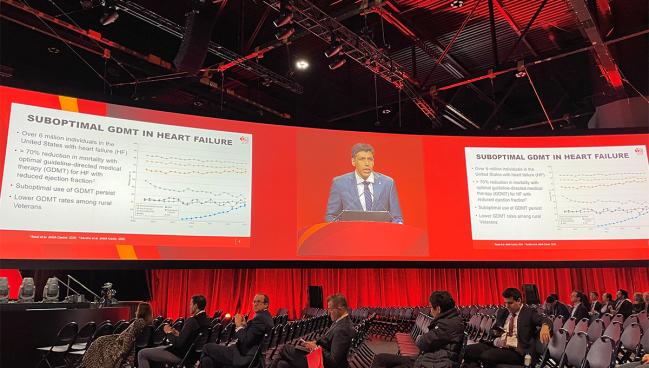Audits and Feedback Aid Pharmacist-Driven HF Care: PHARM-HF A&F
(UPDATED) The improved engagement with HF patients intended to optimize GDMT was very modest, but did lead to increased use of MRAs.

CHICAGO, IL—A quality improvement effort aimed at providing feedback to pharmacists led to more encounters with heart failure (HF) patients being seen in the Veterans Affairs system, and an increase in starting and uptitrating guideline-directed medical therapy (GDMT), results of a new study show.
The change in GDMT was very modest, however, with the improvement driven by greater use of mineralocorticoid receptor antagonist (MRA).
“We really urgently need a multipronged strategy for improving medical therapy amongst patients with heart failure,” said lead investigator Alexander Sandhu, MD (Palo Alto Veterans Affairs Healthcare System/Stanford University, CA). “One potential strategy is to increase the overall population of individuals that are helping with heart failure management. Prior data has shown that pharmacist-based heart failure care increases guideline directed medical therapy use.”
The study, known as PHARM-HF Audit & Feedback (A&F), was presented today during the late-breaking clinical trials session at the American Heart Association (AHA) 2024 Scientific Sessions.
Speaking with the media, Brahmajee Nallamothu, MD (University of Michigan School of Medicine, Ann Arbor), who wasn’t involved in the study, highlighted the boom in medical therapies for the treatment of patients with HF. In the last couple months alone, for example, there have been positive data presented with the nonsteroidal MRA finerenone (Kerendia; Bayer) in FINEARTS-HF, while tirzepatide (Zepbound/Mounjaro; Eli Lilly) was just shown in another AHA late-breaking presentation to be effective in patients who have HF with preserved ejection fraction and obesity.
“We are increasingly producing drugs and therapies that benefit these populations, and yet we have no way of actually getting these therapies to patients on a day-to-day basis,” said Nallamothu.
We really urgently need a multipronged strategy for improving medical therapy amongst patients with heart failure. Alexander Sandhu
With an eye toward improved implementation, the PHARM-HF A&F researchers wanted to learn if a program that provided pharmacists with information on how their treatment patterns compared with peers could alter the number of patient encounters for HF and adjustments of HF medications. Both groups—the intervention arm and usual care—received best-practice documents, titration protocols, and question-and-answer sessions on HF management.
“We were not enrolling specific patients in the study,” he told TCTMD. “We were just enrolling the pharmacists across all these sites and then we analyzed the patient data.”
Maybe Education and Training Is Enough?
The study included 120 primary care pharmacists in the Sierra Nevada VA region (northern and central California, Nevada, and Pacific Islands). In total, 58 pharmacists were randomized to the audit-and-feedback program and 62 to usual care with education. The primary outcome was the number of pharmacy encounters dealing with HF medication 3 to 6 months after randomization.
At baseline, there was an average of two monthly HF encounters per pharmacist. After the intervention, there was a 0.5 increase in monthly HF encounters in the education-only arm, whereas the audit-and-feedback strategy led to an additional 1.2 monthly HF encounters. As for the number of HF encounters that led to a medication adjustment, these improved by 0.2 in the intervention arm compared with the usual care arm: the average at the study outset was four per month before the intervention.
With GDMT, there was no difference in the initiation or uptitration of beta-blockers, renin-angiotensin-system inhibitors, or SGLT2 inhibitors between the two strategies, but the program led to greater initiation and uptitration of MRAs (11.6 vs 9.2 with education alone; P < 0.01).
Sandhu noted there was a substantial variation in the treatment effect across sites. There was practically no effect seen at three of the eight sites, while two had a substantial uptick, increasing to nearly two HF medication encounters per pharmacist per month.
Cynthia Jackevicius, PharmD (Western University of Health Sciences, Los Angeles, CA), the discussant following the late-breaking presentation, said PHARM-HF A&F shows that bringing in pharmacists can boost patient access to HF treatment in the primary care setting. As for the small benefit with the feedback approach, one possibility is that education and training alone might be enough to increase HF encounters and medication changes.
“There might be some cognitive overload with the [audit-and-feedback] reports,” she added. “We all get too many emails and perhaps the reports got lost in the emails.”
Prior meta-analyses have shown that pharmacists can improve the use of GDMT in HF, which then translates into fewer hospitalizations and HF admissions, she noted. This study is unique in that it focuses on ambulatory patients as opposed to inpatient care or postdischarge management.
“The other thing to consider is that this was the primary care setting,” said Jackevicius. “Very few patients had been hospitalized recently for [acute decompensated heart failure] so they’re considered more stable. That doesn’t mean they’re low risk, but from a patient perspective, as well as a clinician perspective, this can result in inertia. If someone’s stable, the impetus to change is not as great.”
Uptitration Poor Even Amongst Cardiologists
To TCTMD, Sandhu explained that pharmacists are embedded within primary care clinics throughout the VA healthcare system and patients are frequently referred to them for the management of various conditions, including hypertension and diabetes. He said that VA pharmacists are encouraged to adopt a broad population-health strategy to check whether patients are being adequately treated and optimized on indicated medications, noting that some are becoming involved in the management of patients with HF.
“They actually use a national heart-failure dashboard in the VA so they can see which of their patients have heart failure and are not on guideline-recommended therapies,” he said.
Some of the patients within the VA system might be seen by cardiologists, either within or outside the system, but the majority are cared for through the primary care clinics, he said. Even when patients are treated by cardiologists, gaps in treatment remain.
“Not only do patients not have enough encounters with cardiology, but when we look at nationwide data, most encounters with cardiology don't include uptitration of medical therapy,” said Sandhu. “There's very little uptitration of therapy over time, which is why we're hopeful that expanding the care team around additional providers, whether it’s nurses or pharmacists that really focus on that uptitration and optimization, is a helpful strategy.”
The researchers are currently performing qualitative assessments of the intervention so that it can be adapted, improved upon, and expanded across additional VA regions next year, he added.
If we can't do this in the VA system, it's really difficult to imagine how this type of model can work outside of that type of setting. Brahmajee Nallamothu
Speaking with the media, Nallamothu praised investigators for their efforts but said results achieved with the intervention were relatively modest, which is somewhat “humbling” given the advantages already built into the VA healthcare system.
“It already has a history of embedded pharmacists working in spaces like hypertension, diabetes, and anticoagulation,” he said. “It's both a great place to study the potential of using pharmacists to help assist us in increasing guideline-directed medical therapy through this audit and feedback mechanism, but it also raises some important challenges, because if we can't do this in the VA system, it's really difficult to imagine how this type of model can work outside of that type of setting.”
It's possible, he added, that investigators didn’t wait long enough to study the impact of the intervention, noting that 6 months is relatively short for assessing behavioral change. Qualitative assessments will be critical to understand where the intervention was successful and what can be done to make it better, he said. Jackevicius said that it is possible patients were already taking maximally tolerated GDMT, noting that not everybody gets to the target dose.
Michael O’Riordan is the Managing Editor for TCTMD. He completed his undergraduate degrees at Queen’s University in Kingston, ON, and…
Read Full BioSources
Sandhu A, on behalf of the PHARM-HF A&F investigators. Evaluation of randomized audit and feedback to increase heart failure medication optimization among primary care pharmacists in the Veterans Affairs Health Care System (PHARM-HF A&F study). Presented at: AHA 2024. November 16, 2024, Chicago, IL.
Disclosures
- Study was funded by the AHA’s Rural Health Equity Research Network and Veteran Affairs QUERI program.
- Sandhu reports research funding from AstraZeneca, Bayer Pharmaceuticals, NIH, Novartis Pharmaceuticals, and Novo Nordisk, as well as consulting fees from Reprieve Cardiovascular.





Comments